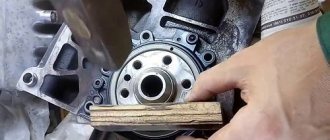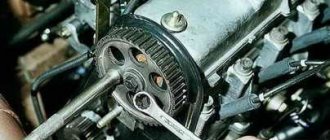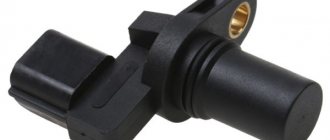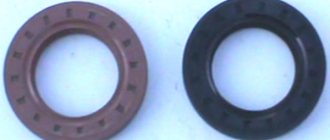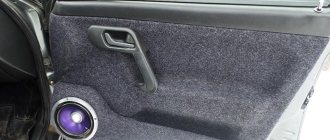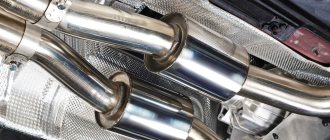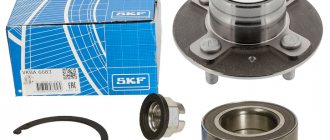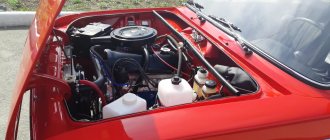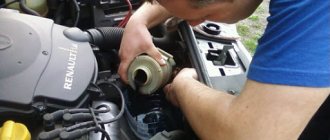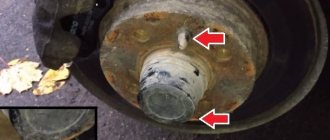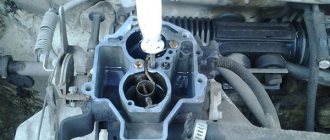31.01.2020
| (Votes: 1, Rating: 5) |
Issues discussed in the material:
- About the purpose and function of the camshaft
- When to replace seals
- How to change a camshaft oil seal: step-by-step instructions
- Opinion of car owners on replacing the camshaft oil seal
Having discovered small oil leaks and understood the cause of the leak, many car owners are wondering how to change the camshaft oil seal with the least effort, preferably with their own hands. The procedure is simple, but there are some nuances.
Next, we will explain in detail what an oil seal is and why it is important to change it if a leak occurs. Step-by-step instructions will help you understand how to make the replacement yourself.
Camshaft: purpose and functions
With the help of the camshaft, the intake and exhaust strokes of the internal combustion engine are synchronized.
The gas distribution mechanism (GRM) has a lower and upper arrangement of valves in the cylinder block, it all depends on the type of engine in your car. Manufacturers of modern cars prefer a timing belt with valves located at the top. This design makes it possible to carry out repair work and maintenance of the camshaft without any problems, because access to the timing elements is quite simplified.
The camshaft and crankshaft of the power unit are structurally interconnected. The connection is made using a belt or chain, which is put on the camshaft pulley and the crankshaft sprocket. The camshaft is driven by the crankshaft.
Probably the most effective camshaft pulley is the split gear, used in camshaft tuning to increase engine power.
The cylinder head contains bearings. They rotate the camshaft bearing journals. During repairs, camshaft repair liners are used to secure the bearing journals. Through a through hole made in the camshaft axis, the rubbing surfaces of the elements are lubricated. At the rear, this camshaft hole is plugged.
The most important part in the camshaft is the cams. The number of these elements corresponds to the number of exhaust and intake valves of the engine. It is they who perform the main tasks of the camshaft - regulating the gas distribution phases of the engine and the operating order of the cylinder.
Any valve has a personal cam that opens it by pressing on the pusher. After the return spring is activated, the cam moves away from the pusher and the valve closes.
The camshaft cams are located between the bearing journals. Each cylinder has two cams: intake and exhaust. In addition, a gear mounted on the shaft drives the oil pump and the distributor-breaker. In addition, there is an eccentric to make the fuel pump work.
The valve timing of the camshaft is determined experimentally. Plus, the design of the intake/exhaust valves and the number of engine revolutions also play a role. Vehicle manufacturers prescribe engine camshaft phases in the form of diagrams and tables.
The upper part of the camshaft is attached to the camshaft supports, where the front cover is common. It has built-in flanges that fit into the grooves in the camshaft journals.
The camshaft is located in the camber of the cylinder block. The crankshaft drives it through a gear or chain transmission. When the camshaft rotates, the cams begin to influence the operation of the intake and exhaust valves. This process proceeds strictly in accordance with the gas distribution phases and the order of operation of the engine cylinders.
To correctly set the valve timing, there are special installation marks located on the drive pulley or on the timing gears. The camshaft cams and crankshaft cranks are located in a strictly defined position relative to each other.
Installation made according to the marks allows you to maintain the sequence of alternating strokes (mode of operation of the engine cylinders). This order depends on the location and design features of the crankshaft and camshaft.
The word “oil seal” or “seal” has remained since ancient times. Then, to seal the moving structural elements, hemp soaked in fat was used. So we got the word “oil seal”, which is incomprehensible at first glance. Of course, today it is difficult to imagine an oil seal that is made of such material. For the manufacture of current seals, modern and reliable materials are used.
The need to replace oil seals
The camshaft oil seal (cuff) is a sealing ring that prevents oil from leaking out of the camshaft. This gasket is equipped with engines that are equipped with a gas distribution mechanism (timing belt). If it suddenly does not perform its tasks, then the seal needs to be changed.
The main reason for malfunction is normal mechanical wear. All seals are common consumables, and after a certain amount of time they begin to deteriorate because they are made of elastic materials.
Any defect may appear: swelling, change in shape, tears, scarring, etc. Another possible malfunction: the cuff can be squeezed out of its seat.
It happens that the cuff is defective or installed (selected) incorrectly. In such situations, it is also necessary to change the camshaft oil seal, because it does not fulfill its intended purpose.
Oil seal failure is diagnosed visually. If it leaks, you can see traces of oil on the timing belt cover. In order to more accurately determine the extent of the problem, you need to remove the belt cover and conduct an inspection. If there is a malfunction, traces of wear will be visible, or due to increased moisture, the belt has jumped over one or a couple of pulley teeth.
We recommend
“Replacing gearbox seals: subtleties and tricks” More details
The fact that the seal is faulty can be seen when it’s time to change the timing belt according to the plan. It is then that oil leaks can be detected on the belt or on the camshaft gear. If the seal is deformed, it should be replaced, despite the fact that oil is not leaking at this moment. However, changing the shape of the oil seal will cause oil traces to appear.
In addition to the above, the element should also be replaced if obvious mechanical damage is detected. This procedure is not urgent, and the car can be operated carefully for a long time. However, you should still know how to change the camshaft seal if it unexpectedly fails.
Moreover, if there are significant oil losses due to a damaged seal or the element is severely damaged, then there is no escape from replacement.
After traveling a certain number of kilometers, the car develops oil traces in the area of the camshaft pulley and oil seal. As the mileage increases, so do the leaks. This situation indicates that it is time to change the camshaft seal.
The problem here is not the loss of oil, but the fact that it is transferred to the timing belt and camshaft drive pulley. This turn of events becomes dangerous because the hot oil causes the rubber of the belt to deform. In this case, the oily liquid makes the belt slippery, and it may begin to slip on the pulley teeth.
As a result, cracks may form on the pistons or bend the valves. Be that as it may, you should change the seal to get rid of oil traces.
Causes of malfunctions
The main cause of the malfunction is simple mechanical wear. Any oil seal is, by its nature, a consumable - after a certain period of time it begins to deteriorate, since it is made of an elastic material.
The malfunction may manifest itself in the form of changes in shape, swelling, scarring, rupture or chipping of the material from which the consumable is made. Another manifestation of a malfunction may be the cuff being completely squeezed out of the seat.
Other causes of problems with the camshaft oil seal are incorrect selection of consumables, manufacturing defects, or incorrect installation. In these cases, the oil seal also does not perform its functions and needs to be replaced.
How to change a camshaft oil seal: step-by-step instructions
Typically, replacing a camshaft oil seal is quite simple because the process is almost the same for all cars.
However, the procedure for replacing the rear and front seals is slightly different. There is nothing unusual here: the front oil seal can be changed directly on the engine, but the rear oil seal cannot be replaced so easily.
In order to change the camshaft oil seal, you need to prepare the following set of tools:
- open-end or ring wrenches 10, 17;
- slotted screwdriver;
- puller;
- torque wrench;
- mount;
- mandrel for pressing;
- some motor oil.
1. Front oil seal.
Let's look at how to change the front camshaft oil seal in order:
- Set the car to the parking brake and neutral.
- Disconnect the battery terminals as for other work in the engine compartment.
- Remove the plastic timing belt cover.
- Remove the valve cover by unscrewing the fastening bolts using a screwdriver.
- Make marks with a marker showing the location of the belt in relation to the camshaft.
- Remove the timing belt. In principle, it is not necessary to remove it completely; it is enough to remove it from the camshaft timing pulley. To do this, use a 17mm wrench to unscrew the fastening bolt, securing the pulley from turning (for example, using a pry bar).
- Remove the pulley from the camshaft shank using a puller. If there are two pulleys at the camshaft, you need to remove both and mark the place where they were located. Such manipulations will help not to confuse them later.
- Next, pull out the key, which is located behind the camshaft pulley.
- Using tweezers or a screwdriver, remove the old oil seal. During the procedure, you should be careful to ensure that the working surface of the camshaft, to which the oil seal is adjacent, remains intact.
Upon completion of dismantling the seal, you should begin installing a new device and then proceed with installation.
We recommend
“Replacing the crankshaft oil seal: why you can’t put it off” Read more
The edge of the oil seal that is adjacent to the camshaft must be lubricated with engine oil. The outer part should be treated with sealant.
Place the seal on the camshaft and press it in using a press mandrel.
The subsequent timing assembly is performed in reverse order:
- Place the key on the camshaft.
- Install the pulley. If there are two pulleys, install each one as it was before.
- Using a torque wrench, tighten the pulleys. In the manual you can see information about the voltage moment. Secure the pulleys using a pry bar so that there is no rotation during tightening, having previously engaged fourth gear in the gearbox.
- Next, pull the belt onto the pulleys, focusing on the marks left in advance. However, first you should inspect the belt for abrasions, damage, etc. Due to the fact that oil seal leaks can only be seen when replacing the timing belt, it often becomes necessary to replace the belt. In such a situation, installation must be done based on the factory marks.
- Tighten the bolt that secures the tension pulley. Look at the tension torque in the vehicle manual.
- Then turn the crankshaft by hand. A few clockwise turns are enough. This method helps to check how the belt is tensioned. If there are any violations, then everything needs to be further adjusted.
- After this, secure the valve cover in place and install the belt cover.
- At the end of the procedure, it is necessary to add oil to the oil tank to the top mark.
2. Rear oil seal.
There is no general plan on how to change the rear camshaft oil seal, because it will be different for each type of car. For some types of vehicles, access to the rear oil seal can only be achieved using a lift or inspection hole by disconnecting the gearbox drive and clutch.
There are car models in which the camshaft position sensor closes the seal. To dismantle the sensor, you need to perform the following steps:
- disconnect the sensor (electrical connector);
- unscrew the screw used for fastening and remove the sensor;
- unscrew the bolt (using a 10mm wrench) securing the gas hose holder to the device wire bracket;
- Unscrew the screws that secure the sensor cover, remove the cover and wires;
- remove the sensor rotor;
- pull out the plate designed to secure the sensor cover.
Now you can remove the rear camshaft oil seal using a screwdriver. Replace in a similar way. After replacing the cuff, reassemble the sensor using the reverse order.
Next, as soon as the installation is completed, you need to check the new oil seal for possible oil leaks. If all actions are performed correctly, then there should be no oil drips even at increased engine speeds. Otherwise, the sensor was installed incorrectly or it was pressed in incorrectly. There is also a possibility of a manufacturing defect of the device.
conclusions
As you can see for yourself, there is nothing complicated about replacing the camshaft oil seal on a VAZ-2112. This work is not primitive, but does not require any special skills. You just need to carefully read this and all the supporting articles and then the repair will not become something unusual for you. After all, by doing such work yourself, you not only save your budget, but also significantly increase your experience in repairing your own car.
If you find traces of oil leakage through the camshaft seals, first check to see if the crankcase ventilation system is clogged and if its hoses are pinched, and if necessary, repair the faults.
If the oil leak does not stop, replace the seals.
Using a 10mm socket, unscrew the six bolts securing the front cover.
Removing the front cover
Using a 17mm spanner, loosen the bolt securing the exhaust camshaft toothed pulley.
By inserting a screwdriver into the pulley hole, we hold it from turning.
In the same way, loosen the bolt of the intake camshaft toothed pulley.
Oil seal catalog number – 2112-1006216
After unscrewing the fastening bolts, remove the camshaft pulleys.
Use a screwdriver to pry up the seals and remove them.
Lubricate the working edge of the oil seal with engine oil.
We press in new oil seals with a suitable piece of pipe
We assemble the timing drive in reverse order.
Opinion of car owners on replacing the camshaft oil seal
1. It is not for nothing that they recommend changing the oil seal when replacing the timing belt.
“When replacing the timing belt, I also changed the seals. It is not clear how you can change the camshaft oil seal without removing the belt. Yes, and it is always recommended to carry out this procedure together, because if one of them leaks, as well as if there is a problem with a pump that was not replaced at the right time, the same actions are performed as when replacing the timing belt.”
2. Didn't take off the belt.
“I changed the camshaft seal two weeks ago. The timing belt and pulley were not removed during replacement. I unscrewed the gear from the camshaft and pulled it towards myself by 3-5 mm, and the belt along the gear, on the contrary, away from itself. An important point is that the camshaft must be positioned so that it is keyed upward, otherwise it will fall behind the timing case. Try it, everything will work out.”
3. Not everything is so simple.
“I replaced three frontal seals: a crankshaft seal and two lower camshafts. I washed the surface with carb. There was nothing complicated, but there was danger. The camshaft has ignition timing or something like that, which results in spring and torque. I removed the first video because I needed to remove the belt. As a result, the two right camshafts sprung and spun, and the marks got lost. In general, the procedure itself was not difficult, except that I had to tighten the belt on the crankshaft gears.”

